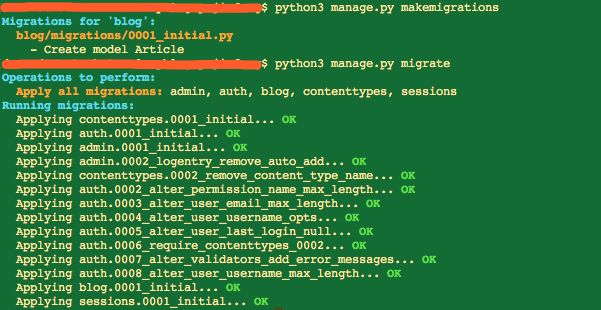前面已经对DTL(Django Template Language)语言基础用法进行了讲解,现在我们开始做一个博客小项目。
1. 准备工作
首先,我们整理一下整个流程,一个简单的博客项目包含博客列表页、博客详情页、博客编辑页、添加博客页,其页面设计如下:
页面设计(Page):
1.博客列表页:所有博客文章列表、写博客按钮 blog/index index.html
2.博客详情页:标题、内容、编辑按钮 blog/article/article_id article_page.html
3.博客编辑页:form表单、标题、内容、提交按钮 blog/article/edit article_edit_page.html
4.添加博客页:form表单、标题、内容、提交按钮
事件(Action):
编辑博客提交Action:post提交(博客标题、id、内容)
新增博客提交Action:post提交(博客标题、内容)
下面,我们来梳理数据及页面跳转:
如上,由于编辑博客、新增博客非常相似,我们就将两个页面合并成一个。
2. 开始编码
1.首先我们创建并配置项目的基本信息
打来终端,找到我们存放python项目的目录python-works(这个存储地址根据你个人喜好选择),然后在终端中输入一下命令:
django-admin startproject myblog
然后cd 到myblog的目录下,执行以下命令
python3 manage.py runserver
用浏览器打开http://127.0.0.1:8000/,出现欢迎界面,说明项目创建成功:
还记得如何把界面修改成中文的吗,进入settings.py,修改以下代码
LANGUAGE_CODE = 'zh-hans' #将'en-us'改为'zh-hans'
TIME_ZONE = 'UTC'
USE_I18N = True
USE_L10N = True
USE_TZ = True
再刷新一下界面,界面即变成中文,此时准备工作已经做完了,接下来我们开始创建博客应用。
2.创建博客应用
仍然打开终端,进入到myblog目录下,输入以下命令创建一个名为blog的应用:
python3 manage.py startapp blog
此时项目中多了一个名为blog的应用:
打开settings.py文件,将blog添加到应用列表中
INSTALLED_APPS = [
'django.contrib.admin',
'django.contrib.auth',
'django.contrib.contenttypes',
'django.contrib.sessions',
'django.contrib.messages',
'django.contrib.staticfiles',
'blog', #添加blog应用到应用列表中
]
此时,我们还未创建任何页面,现在blog下的views.py中定义一个index页,输出一行文字,如下
from django.shortcuts import render
from django.http import HttpResponse
def index(request):
return HttpResponse('我是博客应用页面!')
然后,在myblog文件夹下的urls.py文件中添加一个路径:
from django.conf.urls import url
from django.contrib import admin
from blog.views import index
urlpatterns = [
url(r'^admin/', admin.site.urls),
url(r'^index/', index) #添加index的路径
]
再重启一下服务,我们访问http://127.0.0.1:8000/index,界面上显示了正确的内容
在前面的页面设计中,我们想访问的是blog/index,而不是直接访问index,这个怎么做呢?其实在前面的文章 知识详解2:django之项目下创建应用及注意事项 中有详细的说明,在此不再赘述。我们现在blog下创建一个名为blog_urls.py的文件,然后输入以下内容:
from django.conf.urls import url
from . import views
urlpatterns = [
url(r'^index/', views.index),
]
然后,将系统的urls.py文件修改为
from django.conf.urls import url, include
from django.contrib import admin
from blog.views import index
urlpatterns = [
url(r'^admin/', admin.site.urls),
url(r'^index/', include('blog.blog_urls')),
]
为什么这么干,可以查看前面的文章 知识详解2:django之项目下创建应用及注意事项
再次刷新一下页面,访问http://127.0.0.1:8000/blog/index,即显示了正确的内容。至此,blog项目的准备工作做完了,接下来我们来创建页面。
3.博客列表页
前面已经在界面上显示了一行文字,但是这个不是我们想要的,我们需要显示一个界面,然后在界面上显示数据库的文章列表,前文 知识详解3:django之创建Template文件 详细讲解了如何创建页面。
首先,我们在blog文件夹下创建一个名为templates的文件夹,并添加一个index.html文件,然后修改blog下的views.py的内容,让views返回index.html
from django.shortcuts import render
from django.http import HttpResponse
def index(request):
return render(request, 'index.html') #render函数有三个参数,此处只传了两个
此时,访问http://127.0.0.1:8000/blog/index,显示的是一个空页面,这是因为我们既没有向index.html文件中传递数据,也没有在index.html中写显示数据的逻辑,接下来,我们准备数据源。前文 知识详解4:django之models与数据表 中有详细的解释。
在blog的models.py中创建博客对象,包含title、content两个字端(系统默认会添加一个id),models.py的代码如下:
from django.db import models
class Article(models.Model):
title = models.CharField(max_length=32, default='')
# 文章正文,使用的是TextField
# 存储比较短的字符串可以使用 CharField,但对于文章的正文来说可能会是一大段文本,因此使用 TextField 来存储大段文本。
content = models.TextField(null=True)
然后在终端中执行以下命令:
python3 manage.py makemigrations
成功后继续执行
python3 manage.py migrate
接下来,我们为该项目创建一个名为yucanghai,密码为root123456的超级用户,在登录django后台之前,我们需要在blog下的admin.py中配置一下
from django.contrib import admin
from .models import Article
admin.site.register(Article) #必须增加这一行,否则进入后台什么都没有
接下来,我们登录后台增加几篇博客,如下:
此处显示的全部是Article object,我们调整一下models.py的代码:
from django.db import models
from django.contrib.auth.models import User
class Article(models.Model):
title = models.CharField(max_length=32, default='')
# 文章正文,使用的是TextField
# 存储比较短的字符串可以使用 CharField,但对于文章的正文来说可能会是一大段文本,因此使用 TextField 来存储大段文本。
content = models.TextField(null=True)
def __str__(self): #增加该方法
return self.title
刷新界面,显示如下:
现在,我们需要将数据库中的博客数据读取出来,显示在index.html文件中。在blog下的views.py文件中读取数据并传递给index.html,调整views.py代码如下:
from django.shortcuts import render
from django.http import HttpResponse
from . import models
def index(request):
articles = models.Article.objects.all()
#这里是取所有,如果取某一个article = models.Article.objects.get(pk=1)
return render(request, 'index.html', {'articles': articles})
修改index.html文件,将内容显示出来:
首页
我的博客列表:
{% for article in articles %} #这是DTL的语法,
{{ article.title }} #此处先不添加跳转页面,稍后再添加
{% endfor %} #for循环必须以这个结尾
好,我们的博客首页已经完成了,接下来做博客详情页。
4.博客详情页
在templates文件夹下新建一个名为article_page.html的页面,这个页面的作用就是显示博客的详细内容,这个页面的数据就是上一页面传递过来的博客对象,我们先编写显示代码:
博客详情页
标题: {{ article.title }}
内容: {{ article.content }}
现在的问题是要从views中将article对象传递给该页面,所以我们在view.py中增加:
from django.shortcuts import render
from django.http import HttpResponse
from . import models
def index(request):
articles = models.Article.objects.all()
return render(request, 'index.html', {'articles': articles})
def article_page(request, article_id): #根据博客id获取博客内容
article = models.Article.objects.get(pk=article_id)
return render(request, 'article_page.html', {'article': article})
根据上一个页面传递的article_id获取到这个article对象,并传递给html页面显示出来,那这个article_id该怎么传递过来呢?参照前面的页面设计中,我们的设计是访问博客详情页的地址是 http://127.0.0.1:8000/blog/article/1 ,这个id可以从访问的URL中传递,我们来修改传递的url,打开blog_urls.py文件:
from django.conf.urls import url
from . import views
urlpatterns = [
url(r'^index/', views.index),
url(r'^article/(?P[0-9])$', views.article_page),
]
这里正则表达式为何这么些,会在我的文章中有专门的模块来讲,知道这个article_id是这么传递的即可,运行一下服务器,我们访问一下http://127.0.0.1:8000/blog/article/1 是不是可以显示正确的内容了呢。这里需要注意的是DTL下,models自动生成的id的下标是从1开始的,而不是0.
两个页面做好了,我们现在需要在index.html中增加点击标题的跳转链接
第一种方式:
首页
我的博客列表:
{% for article in articles %}
{{ article.title }}
{% endfor %}
再运行一下,刷新页面,可以正常跳转了。但是,这种跳转逻辑是最基础的,但是当应用中有很多页面的时候,这种方式显的不灵活,现在看第二种方法。
第二种方式:
首先,在项目的urls.py中为博客应用增加一个namespace:
from django.conf.urls import url, include
from django.contrib import admin
from blog.views import index
urlpatterns = [
url(r'^admin/', admin.site.urls),
url(r'^blog/', include('blog.blog_urls', namespace='blog')),
]
然后,在blog_urls.py中为博客详情页增加一个namespace:
from django.conf.urls import url
from . import views
urlpatterns = [
url(r'^index/', views.index),
url(r'^article/(?P[0-9]+)$', views.article_page, name='article_page'),
]
这两步操作相当于给博客应用和博客详情页面增加一个别名,为后面调用提供一种快捷方式。我们再回到index.html中,修改href:
首页
我的博客列表:
{% for article in articles %}
{{ article.title }}
{% endfor %}
我们将href修改成DTL的另外一种表达方式,href="{% url 路径 参数 %}",其中路径就是我们前面定义的不同层级namespace由大到小排列,如果没有参数可以不写。
至此,我们的博客首页和详情页已经完善,现在我们需要在博客首页增加一个新增按钮用于跳转到发博客页面,在博客详情页增加一个编辑按钮,用于跳转到博客编辑页面,我们先将index.html修改如下:
首页
我的博客列表:
{% for article in articles %}
{{ article.title }}
{% endfor %}
写博客
博客详情页article_page.html修改如下:
博客详情页
标题: {{ article.title }}
内容: {{ article.content }}
编辑
新增博客和编辑博客页面相似,我们就使用同一个页面,接下来我们编写编辑页面。
5.编辑博客页
首先,我们在templates下新建编辑页面article_edit_page.html页面
编辑博客页面
这里是定义了一个form表单,用于填写博客标题、内容,并提交,在form中定义了一个action,这个是当提交按钮点击时触发的事件,暂时我们先空着。接下来,我们在views中增加编辑页面的响应函数:
from django.shortcuts import render
from django.http import HttpResponse
from . import models
def index(request):
articles = models.Article.objects.all()
return render(request, 'index.html', {'articles': articles})
def article_page(request, article_id):
article = models.Article.objects.get(pk=article_id)
return render(request, 'article_page.html', {'article': article})
def article_edit_page(request):
return render(request, 'blog/article_edit_page.html') #暂时不传递参数
然后在blog下的blog_urls.py中增加编辑页面的访问路径:
from django.conf.urls import url
from . import views
urlpatterns = [
url(r'^index/', views.index),
url(r'^article/(?P[0-9]+)$', views.article_page, name='article_page'),
url(r'^article/edit/$', views.article_edit_page),
]
OK,我们访问一下http://127.0.0.1:8000/blog/article/edit/ ,此时编辑页面就显示出来了,这个页面暂时是空页面,并为传递任何参数:
下面,我们需要增加提交按钮的响应事件,提交按钮点击时需要有一个响应函数,并有访问该函数的路径,所以我们在viwes中增加响应函数:
from django.shortcuts import render
from django.http import HttpResponse
from . import models
def index(request):
articles = models.Article.objects.all()
return render(request, 'index.html', {'articles': articles})
def article_page(request, article_id):
article = models.Article.objects.get(pk=article_id)
return render(request, 'article_page.html', {'article': article})
def article_edit_page(request):
return render(request, 'article_edit_page.html')
def article_edit_page_action(request):
title = request.POST.get('title', '默认标题') ##get是根据参数名称从form表单页获取内容
content = request.POST.get('content', '默认内容')
##保存数据
models.Article.objects.create(title=title, content=content)
##数据保存完成,返回首页
articles = models.Article.objects.all()
return render(request, 'index.html', {'articles': articles})
再为响应函数增加访问路径,打开blog下的blog_urls.py,修改如下:
from django.conf.urls import url
from . import views
urlpatterns = [
url(r'^index/', views.index),
url(r'^article/(?P[0-9]+)$', views.article_page, name='article_page'),
url(r'^article/edit/$', views.article_edit_page, name='article_edit_page'),
url(r'^article/edit/action$', views.article_edit_page_action, name='article_edit_page_action'),
]
为action增加一个访问路径,并定义一个namespace,接下来,我们在article_edit_page.html中设置action:
编辑博客页面
和前面一样,为action增加响应函数的路径,这里不需要参数。csrf_token是一种网络的攻击方式,具体可以参考CSRF Token介绍与应对策略。现在需要为首页的写博客按钮增加跳转逻辑,打开index.html:
首页
我的博客列表:
{% for article in articles %}
{{ article.title }}
{% endfor %}
写博客
此时刷新界面,在首页点击“写博客”即可跳转到编辑博客页面,填写内容提交会保存数据并跳转到首页面。
现在需要编写博客详情页的编辑按钮的功能,点击编辑按钮需要将这篇文章的id传递到编辑页面,在编辑页面填充该博客。既然写新博客和编辑都是跳转到同一个页面,而编辑时需要传递参数,而写博客不需要传递参数,为了兼容,我们都传递一个参数,写新博客时传递一个0,以做区别,首先,我们修改views下的编辑页面响应函数:
from django.shortcuts import render
from django.http import HttpResponse
from . import models
def index(request):
articles = models.Article.objects.all()
return render(request, 'index.html', {'articles': articles})
def article_page(request, article_id):
article = models.Article.objects.get(pk=article_id)
return render(request, 'article_page.html', {'article': article})
def article_edit_page(request, article_id):
#str方法将参数转化为字符串,避免因传递类型差异引起的错误
# 0代表是新增博客,否则是编辑博客,编辑博客时需要传递博客对象到页面并显示
if str(article_id) == '0':
return render(request, 'article_edit_page.html')
article = models.Article.objects.get(pk=article_id)
return render(request, 'article_edit_page.html', {'article': article})
def article_edit_page_action(request):
title = request.POST.get('title', '默认标题') ##get是根据参数名称从form表单页获取内容
content = request.POST.get('content', '默认内容')
##保存数据
models.Article.objects.create(title=title, content=content)
##数据保存完成,返回首页
articles = models.Article.objects.all()
return render(request, 'index.html', {'articles': articles})
这里是传递的有参数的,我们需要修改blog_urls下修改博客详情页的访问路径,增加参数
from django.conf.urls import url
from . import views
urlpatterns = [
url(r'^index/', views.index),
url(r'^article/(?P[0-9]+)$', views.article_page, name='article_page'),
url(r'^article/edit/(?P[0-9]+)$', views.article_edit_page, name='article_edit_page'), #路径中传递页码
url(r'^article/edit/action$', views.article_edit_page_action, name='article_edit_page_action'),
]
然后修改index.html,在点击写博客时传递0
写博客
修改article_page.html,为编辑按钮增加参数:
a href=" {% url 'blog:article_edit_page' article.id %} ">编辑
接下来,我们修改article_page_edit.html,当从博客详情页进入时显示博客内容,从首页进入时不显示内容:
编辑博客页面
很好理解是不是,有博客就显示,没有就不显示。现在问题来了,在编辑页面,点击提交按钮到底是新增还是保存呢,现在我们需要在views中修改action的响应函数:
from django.shortcuts import render
from django.http import HttpResponse
from . import models
def index(request):
articles = models.Article.objects.all()
return render(request, 'index.html', {'articles': articles})
def article_page(request, article_id):
article = models.Article.objects.get(pk=article_id)
return render(request, 'article_page.html', {'article': article})
def article_edit_page(request, article_id):
#str方法将参数转化为字符串,避免因传递类型差异引起的错误
# -1代表是新增博客,否则是编辑博客,编辑博客时需要传递博客对象到页面并显示
if str(article_id) == '0':
return render(request, 'article_edit_page.html')
article = models.Article.objects.get(pk=article_id)
return render(request, 'article_edit_page.html', {'article': article})
def article_edit_page_action(request):
title = request.POST.get('title', '默认标题') ##get是根据参数名称从form表单页获取内容
content = request.POST.get('content', '默认内容')
article_id = request.POST.get('article_id_hidden', '0') ##隐藏参数,参数是在web中定义
##保存数据
##如果是0,标记新增,使用create方法,否则使用save方法
##新增是返回首页,编辑是返回详情页
if str(article_id) == '0':
models.Article.objects.create(title=title, content=content)
##数据保存完成,返回首页
articles = models.Article.objects.all()
return render(request, 'index.html', {'articles': articles})
article = models.Article.objects.get(pk=article_id)
article.title = title
article.content = content
article.save()
return render(request, 'article_page.html', {'article': article})
然后我们修改article_page_edit.html页面,处理传递id和不传递id时提交事件的响应方法:
编辑博客页面
运行一下程序,是不是新增和编辑功能都正常了呢,✌️!好了,整个博客小项目编写完成了。
点击下载完整的项目代码
3.小结
这个小demo非常基础,主要是讲解DTL语言的用法。从应用创建的设置,到应用中页面的显示、事件的处理,在后面的文章中我会写比较复杂的项目。








